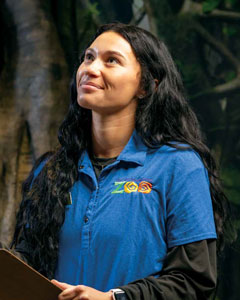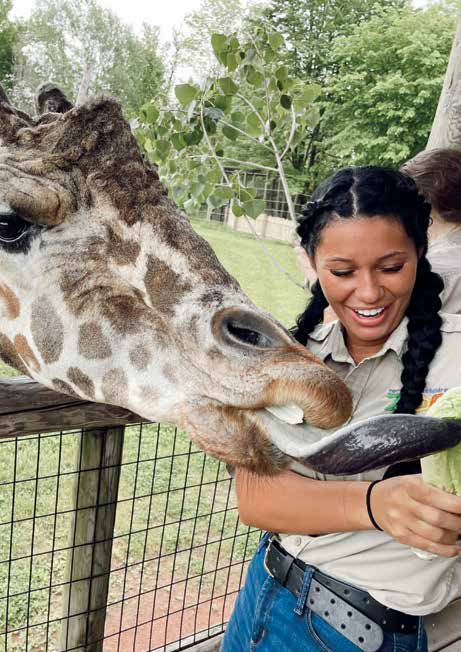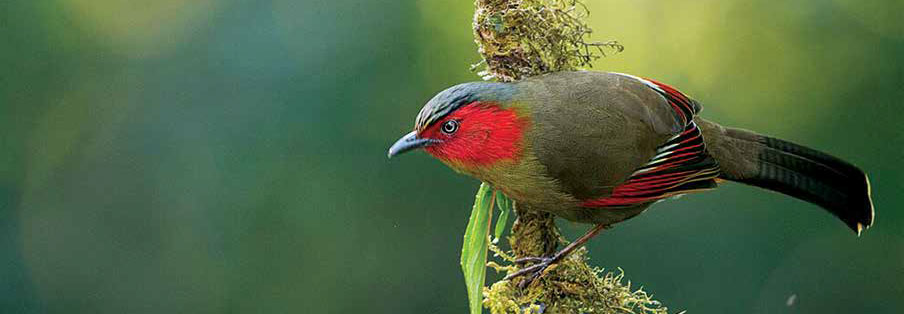Wild Ambition

From the time she was a first-grader, Karlee Barnhill has wanted to be a veterinarian. She remembers distinctly dressing up as a vet and creating a poster about her dream job for her elementary school’s career day.
Since then, the Indiana Tech senior from Jonesville, Michigan, has answered that calling by working with animals—primarily her family’s horses (as a barrel racer and with her mom, who was a farrier). She grew up in 4-H, showing livestock, and was a member of Future Farmers of America. Over the last two years, she has worked in the Fort Wayne area for a veterinary hospital and an equine clinic.
Barnhill’s love for animals is so strong she “celebrated” her 21st birthday helping deliver
around-the-clock intensive care to a Belgian foal that was born in distress just hours earlier. The foal survived, thanks in large part to her unwavering dedication.
Ultimately, Barnhill’s passion led her to Indiana Tech to pursue a Bachelor of Science in Biology and prepare for veterinary school (more about that, later).
“From a time before I could even walk, when I used to help my mom shoe horses, I’ve been immersed in caring for animals and understanding the special bond we share with them,” Barnhill said. “Through my experiences, I’ve come to understand the profound impact that they have on our lives and the responsibility we hold to ensure their well-being. This is what drives my passion for animal welfare and advocacy, and why I have never wavered on becoming a veterinarian.”
So, when Barnhill got the opportunity to spearhead a project at the Fort Wayne Children’s Zoo that could affect the comfort, health and well-being of animals, she leapt at the chance.

Barnhill’s project—her senior project—deals with bioacoustics: the study of the production, transmission and reception of animal sounds, which is used to provide scientists and researchers with insight into species diversity, habitat health and wildlife behavior.
In this case, Barnhill has been studying the calls of the zoo’s two pair-bonded scarlet-faced liocichlas (Jeruk is the male, Kirmizi is the female). These birds (along with 53 others totaling 17 different species) call the zoo’s 8,000-square-foot, rainforest-inspired Asian Trek domed habitat their home. Her sound data was captured by the zoo’s specialized
bioacoustics recording equipment installed within the habitat.
The scarlet-faced liocichla is a stunningly beautiful, medium-sized bird whose natural habitat is roughly 9,000 miles away in the dense hill forests, jungles and swamps of Thailand and Myanmar. Described as “furtive and shy,” according to birdsoftheworld. org, and commonly found “singly, in pairs or in small groups of four to five individuals,” the scarlet-faced liocichla is common to its native region. Its calls are distinct, which is one reason it was chosen for this study.
Last fall, Barnhill began poring over sound data to identify how the birds’ vocalizations differ in response to the various stimuli they encounter within the habitat. Those stimuli include things like food availability, interactions with other species, noise outside of the domed habitat, the presence of humans when the zoo is open and mating season. Her work culminated with a presentation of her findings and recommendations to Fort Wayne Children’s Zoo leadership in April.
“I identified distinct patterns that indicated different emotional states, particularly distinguishing between what appeared to be anger and happiness in the birds. When the scarlet-faced liocichlas exhibited what I interpreted as angry calls, there was often increased agitation and aggression within the dome. On the other hand, when they emitted calls that associate with happiness, I observed more relaxed behaviors and positive social interactions within the dome,” Barnhill said.
She concluded that implementing enriched soundscapes that promote positive emotional states will improve the overall welfare of these and, perhaps, other birds in the habitat. She also recommended that the zoo continue to collect and assess data throughout the 2024 season to gain a more comprehensive understanding of how the presence of zoo visitors affects the emotional states of its scarlet-faced liocichlas.
“Ongoing observation and analysis will provide valuable insights into the effectiveness of any interventions that are implemented. It will also enable the zoo to make informed decisions regarding future management strategies for these birds,” Barnhill said.
Because of her experiences growing up, Barnhill is privy to the cues of a horse or other species of hoofstock in discomfort or experiencing discontent. Identifying those cues from a bird? That’s been more of a challenge that has taught valuable lessons.
“This project has reminded me that just because you think everything is going fine for an animal, you can be very wrong. You cannot rely on appearances and assumptions alone,” Barnhill said. “Animals cannot speak to us, so we need to make use of the tools that are available to us to dig deeper and make sure they are happy and that their needs are being met.”
Barnhill’s senior project is part of an 18-credit hour final semester in the homestretch of her college career. And, as mentioned earlier, she has been trying to get into vet
school. Needless to say, she does not have time to dally. But, determination is something Barnhill has never lacked.
“Growing up, it was almost impossible to think I could do this. I’m a first-generation college student with six siblings, and there just wasn’t a big push for me to go to college,” Barnhill said. “My parents didn’t really know how to support my desire to become a vet, so I’ve had to figure out a lot of things on my own.
“I don’t have negative feelings toward my parents but at the same time, I want to be the first person in my family who is able to put Dr. in front of their name,” she added. “That has been a big encouragement to me—changing up some of those generational patterns in my family.”
On March 25, becoming a doctor came closer to reality for Barnhill. On that day, she received an acceptance letter from Ross University School of Veterinary Medicine, which is based in St. Kitts and Nevis, West Indies.
“To be honest, I still don’t know how to react to the news,” Barnhill said about her acceptance into Ross. “There are only 32 vet schools in the country with 100 seats each, and interest in animal medicine is growing. Just getting an interview in such a competitive environment was amazing to me. To be accepted? Well, I am just over the moon!”
Barnhill is still awaiting decisions from two other schools; those should come in April. At that time, she will decide where to pursue her Doctor of Veterinary Medicine.
Karlee’s mentor at Indiana Tech, professor of biology Dr. Julie Good, knows Karlee is ready for the next step in her educational journey.
“Karlee has approached her academic experience here at Tech with a disciplined focus, tackling challenging coursework head-on to become best prepared for the rigor of veterinary education,” Dr. Good said. “She has a love and respect for animals that was instilled in her early in her life and has an exceptional determination. I have no doubt that Karlee will make an outstanding veterinarian.”
“It’s important for everyone to know that even if you don’t come from a certain background, you can still become what you want to be if you put your mind to it and work for it,” Barnhill said. “Most of my life, I’ve thought, ‘I can’t be a doctor. No one in my family is a doctor.’ And now I’m more than halfway there and getting a step closer every day. It’s amazing.”
For her senior project, Barnhill analyzed the acoustic data from these birds to assess the welfare of these and other birds living inside the zoo’s rainforest-inspired Asian Trek domed habitat.
Want to see something sweet? Watch Karlee share her veterinarian school acceptance letter with her fiancé, Landon.
